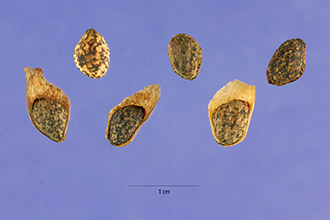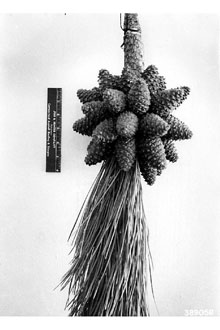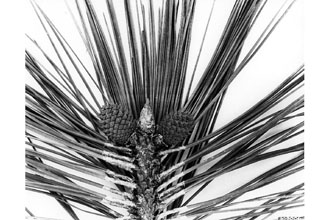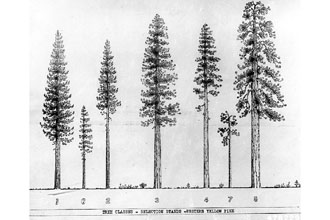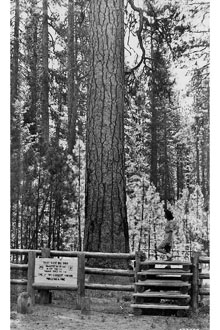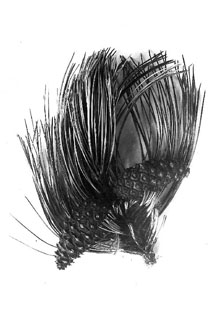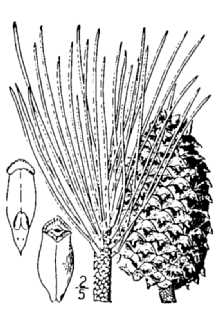Ponderosa Pine
Scientific Name: Pinus ponderosa Lawson & C. Lawson

| General Information | |
|---|---|
| Usda Symbol | PIPO |
| Group | Gymnosperm |
| Life Cycle | Perennial |
| Growth Habits | Tree |
| Native Locations | PIPO |
Plant Guide
Alternate Names
Big heavy, black jack, bull pine, ponderosa white pine, Sierra brown bark pine, silver pine, western pitch pine, western red pine, western yellow pine, yellow pine, Yosemite pine.
Uses
Erosion control: Ponderosa pine is a rapid growing tree with the ability to firmly anchor into most soil types. For this reason, it is suitable for use as a windbreak species. It can also be used with other natives to provide cover and erosion control on rehabilitated sites. Ethnobotanic: Native Americans used various parts of ponderosa pine for medicinal, building and household, food, and ceremonial purposes. Needles were used as dermatological and gynecological aids. They were also used to reduce coughs and fevers. The pitch was used as an ointment for sores and scabby skin, backaches, rheumatism, earaches, inflamed eyes, and as a sleeping agent for infants. The boughs of the plant were used in sweat lodges for muscular pain, as decoctions for internal hemorrhaging, and as infusions for pediatric treatments. The roots of ponderosa pine were used to make blue dye and needles were used as insulation for underground storage pits. The wood was used extensively for fence posts, boards for general construction, and to fabricate snowshoes. Single logs were used to make dugout canoes. Bark was used to cover houses. Banner, R. 2002. Utah State University Extension. Most parts of the plant were used for food, including the pitch, seeds, cones, bark, buds, and cambium. The pollen and needles were used in healing ceremonies. Ornamental value: Ponderosa pine has a lush green color and pleasant odor that makes it popular for ornamental plantings. It has been planted, sometimes out of its natural range, because of its aesthetic qualities. Ponderosa pine is used as borders of forested highways, but is not planted within the right-of-way. The large stature of the tree limits its use to open spaces. Wildlife: Red-winged blackbirds, chickadees, mourning doves, finches, evening grosbeak, jays, Clark's nutcracker, nuthatches, rufous-sided towhee, turkeys, chipmunks and squirrels consume the seeds of ponderosa pine. Blue and spruce grouse use ponderosa pine needles for nesting material. Mice, porcupines, and other rodents use the bark for nesting material. The trees are also important to various birds for cover, roosting and nesting sites. Wood production: Ponderosa pine is one of the most important timber species in the western United States. The annual production of ponderosa pine is ranked third behind Douglas fir and hem-fir. Approximately 1.3 billion board feet of ponderosa pine lumber is produced annually out of Oregon, the largest supplier in the United States. It is popularly used for the construction of buildings.
Description
General: Pine Family (Pinaceae). Ponderosa pine is a large tree that lives 300 to 600 years and reaches heights of 30 to 50 m tall and 0.6 to 1.3 m in diameter. The oldest trees can exceed 70 m in height and 2 m in diameter. The bottom one-half of the straight trunk is typically without branches. The crown of ponderosa pine is broadly conical to round-shaped. The bark is characteristically orange-brown with a scaly plate-like appearance. Twigs are stout, up to 2 cm think, orange-brown, and rough. Needles are 12 to 28 cm long, thin and pointed with toothed edges, occur in bundles of three, and give a tufted appearance to the twig. Buds are up to 2 cm long, 1 cm wide, red-brown with white-fringed scale margins. Male cones are orange or yellow and are located in small clusters near the tips of the branches. The female cone is oval, woody, 8 to 15 cm long, with a small prickle at the tip of each scale. Flowering occurs from April to June of the first year, and cones mature and shed winged seeds in August and September of the second year. Distribution: Ponderosa pine is distributed from southern British Columbia through Washington, Oregon, and California, and east to the western portions of Texas, Oklahoma, Nebraska, North Dakota, and South Dakota. For current distribution, please consult the Plant Profile page for this species on the PLANTS Web site (http://plants.usda.gov). Habitat: Ponderosa pine trees occur as pure stands or in mixed conifer forests in the mountains. It is an important component of the Interior Ponderosa Pine, Pacific Ponderosa Pine-Douglas fir, and Pacific Ponderosa Pine forest cover types. In the northwest, it is typically associated with Rocky Mountain Douglas fir, lodgepole pine, grand fir, and western larch. In California it is associated with California white fir, incense cedar, Jeffrey pine, sugar pine, coast Douglas fir, California black oak, and western juniper. In the Rocky Mountains and Utah, it is associated with Rocky Mountain Douglas fir, blue spruce, lodgepole pine, limber pine, and quaking aspen. In the Black Hills, it is associated with quaking aspen, white spruce, and paper birch. In Arizona and New Mexico, it is associated with white fir, Rocky Mountain Douglas fir, blue spruce, quaking aspen, gamble oak, and southwestern white pine at higher elevations and Rocky Mountain juniper, alligator juniper, and Utah juniper at lower elevations (Oliver & Riker 1990). Shrubs and grasses typically associated with ponderosa pine within its range include ceanothus, sagebrush, oak, snowberry, bluestem, fescue, and polargrass.
Adaptation
The USDA hardiness zones for ponderosa pine range from 3 to 7. It grows on a variety of soils from shallow to deep, and from gravelly sands to sandy clay loam. It is found growing on bare rock with its roots in the cracks and crevices. It has a low tolerance to alkalinity, preferring soils with a pH of 6.0 to 7.0. It grows best in zones with 30 to 60 cm average annual precipitation on well-drained soils. Once established it also survives hot and dry conditions, exhibiting medium to good drought tolerance. Fifty percent shade reduces the growth rate significantly. It withstands very cold winters. Ponderosa pine is a climax species at the lower elevations of the coniferous forest and a mid-successional species at higher elevations where more competitive conifers are capable of growing. It generally grows at elevations between sea level and 3,000 m. The populations at higher elevations usually occur within the southern part of its range (Oliver & Riker 1990).
Establishment
Site preparation is needed to control competition, which compromises seedling survival and growth. Seeds are sown in late March to early April. The seed is sown for an initial density of 237 seedlings/m2 (22 seedlings/ft2). Transplant stock should be one or two years old, with less than 2 prior transplantings, and 15 to 30 cm in height. Space the plants 1 to 3 m apart depending on the site. Initial seedling survival is reduced under moisture stress. Older seedlings can tolerate limited moisture. Competition from other vegetation should be controlled for the first three to six years until the trees become well established.
Management
Ponderosa pine can be over-irrigated in poorly drained soils, or drowned out on high water table sites. It responds well to thinning, which should be done as stands become older to develop larger crowns, resulting in heavier seed crops for wildlife. More forage for deer and elk become available from associated plants by opening the canopy. The use of repellents or other control measures may be necessary to prevent overuse of the trees by rodents. Ponderosa pine is resistant to fire due to its thick bark. Low intensity surface fires control competitive species like scrub oak and shade-tolerant conifers. Ponderosa pine seedlings can also survive low intensity burns.
Pests and Potential Problems
Approximately 200 insect species affect ponderosa pine from its cone stage to maturity. Pine cone beetles cause tree death by transmitting blue stain fungus to the tree. Their larvae also consume the phloem, restricting the flow of nutrients to the top of the tree. Western pine beetle is a common cause of death for older trees, drought stressed trees, and even healthy, vigorous trees during epidemics. Bark beetles are naturally present in all stands. Harvesting methods that leave large amounts of logging slash can allow bark beetle populations to explode and kill vigorous trees up to 0.5 m in diameter. The ponderosa pine budworm, also known as the sugar-pine tortrix, eats new needles on trees in New Mexico and Colorado. Several years’ worth of damage will affect the health of the tree. Early research suggests that some insecticides may help to control infestations. Dwarf mistletoe is the most widespread parasite that causes branch and stem deformation. It germinates on ponderosa pine branches and forces its roots into the phloem of the host branch, creating stem cankers that leave the wood weak and unsuitable for use as lumber. This weakens the tree and leaves it susceptible to fungal infections and insect attacks. Root diseases, rusts, trunk decays, and needle and twig blights also cause significant damage.
Seeds and Plant Production
Plant Production
Plant Production
Ponderosa pine is propagated by seed, Cones are ready for collection in October and November when they turn reddish brown, Mature seed is firm and brown in color, Use soil moisture sensors to measure the soil moisture of Ponderosa Pine., Cones should be dried on canvas tarp in a well-ventilated area immediately after they have been collected, The seeds will drop from the cones as they dry, Several germination methods for ponderosa pine have been utilized, each with their own variations, In general, seeds undergo an imbibation treatment before stratification, Seeds are placed in mesh bags and soaked in cold running water for 48 hours, One variation is to soak the seeds in a 40% bleach solution for 10 minutes with hand agitation prior to placing them under running water, The mesh bags are place in plastic bags and stored at 1oC for 2 to 8 weeks, They should be checked daily for mold, Seeds are sown into containers and covered with media, The media should be kept moist throughout germination, Germination will occur at an average greenhouse temperature of 20oC, Alternating greenhouse temperatures of 21-25oC during the day and 16-18oC at night is an appropriate environment for germinating seeds, Germination will occur in approximately 15 days, Seedlings are thinned and watered daily throughout the establishment phase, They should not be moved outdoors until after the last frost of the year, Seeds can be dried to between 5 and 8% moisture and placed in airtight plastic bags, then stored for long periods of time in freezers set at –15oC, Cultivars, Improved and Selected Materials (and area of origin) Contact your local Natural Resources
Conservation
Service (formerly Soil Conservation Service) office for more information. Look in the phone book under ”United States Government.” The Natural Resources Conservation Service will be listed under the subheading “Department of Agriculture.”
Fact Sheet
Alternate Names
western yellow pine, yellow pine, bull pine, blackjack , Use soil moisture sensors to measure the soil moisture of Ponderosa Pine.
Uses
Beautification: This is a handsome tree for purposes of beautification but due to its height should not be grown within road rights-of-way. Erosion Control: This tree with its native understory is an excellent erosion control cover. It is one of the best evergreens for windbreaks. Livestock: The young tree itself is not eaten by livestock unless most of the other browse species have been destroyed by overgrazing. When eaten by cows during gestation this species may cause abortion. Recreation: Some of the finest campgrounds and picnic areas in the west are found in native stands of ponderosa pine. Trees are stable and generally wind-firm with little danger of top breakage. Wildlife: While deer, elk and mountain sheep do not eat the needles unless other browse species are totally absent, they do feed on the understory species. The seeds of ponderosa pine are choice food of red-winged blackbirds, chickadees, mourning doves, finches, evening grosbeaks, jays, Clark's nutcrackers, nuthatches, white-throated sparrows, rufous-sided towhees, turkeys, chipmunks and squirrels. The pine needles are important food of blue and spruce grouses. The pine bark is fair food for beavers, and is used by porcupines which sometimes damage the trees. Nuthatches dig nest holes in dead trees. Gerald and Buff Corsi © California Academy of Sciences @ CalFlora Wood Products: It is used in small extent for Christmas trees but not well suited to cultural work for this purpose. It makes excellent lumber for cabinet and construction work. It is used for veneer, core stock and sheathing. It is used for paper pulp but demand is low. It is used for poles and has fair durability for posts. It is used for fuel especially for fireplaces.
Status
Please consult the PLANTS Web site and your State Department of Natural Resources for this plant’s current status (e.g. threatened or endangered species, state noxious status, and wetland indicator values).
Description
Pinus ponderosa P. & C. Lawson, is a large, long-lived, native forest tree common throughout the western U.S. Height of mature trees range from 55 to 90 feet. Diameter breast high ranges from 15 to 35 inches. Age at maturity ranges from 70 to 250 years. The needles are 3 to 5 inches long with 3, or rarely 2 to 4, needles in a cluster (bundle). The needles usually remain on the stem 3 to 4 years with the major needle drop in September and October. The cones are pineapple-shaped, 3 to 6 inches long, and take 2 years to mature. The bark is dark brown to nearly black when young and turns from cinnamon brown to orange-yellow at about 90 years of age. This tree has a deep tap root except on shallow soils where roots often follow cracks for considerable distance. This tree is well adapted to grow on bare rock with its roots following crevices or cracks in the rock.
Adaptation and Distribution
Distribution
Distribution
Average annual-precipitation in the plant’s range is from 12 to 40 inches or more. It will grow well in hot, dry sites and can withstand very cold winters. It is very drought tolerant but can be drowned out by high water and still show surprising water tolerance in some situations. The plant is found on a wide variety of soils from shallow to deep, and from gravely or cobbly sands to sandy clay loam and loams in texture, but mostly on sandy loams. It is adapted to grow on bare rock with its roots in the cracks. It has low alkalinity tolerance growing on soils with pH 6.0 to 7.0. Has low water table tolerance and medium drought tolerance. Slopes vary from 2 to 50%. Elevation varies from 6000 to 8500 feet. Topography is gentle to steep mountain slopes, ridgetops and mesas. Ponderosa pine is distributed throughout the west and midwestern United States. For a current distribution map, please consult the Plant Profile page for this species on the PLANTS Website.
Establishment
Site preparation is needed to control competition. Use transplant stock 1-1, 2-1 or 2-2. Plant stock 5 to 9 feet apart depending on site. Seed matures August to November on trees over 20 years old. A good seed crop may be produced every 2 or 3 years but good conditions for seedling establishment may occur only every 20 to 25 years on the poorer sites.
Management
Young stands should be protected from over-grazing by livestock when green feed is limited. Use of tree foliage by livestock usually indicates excessive overuse of the associated plants. By proper grazing use of the understory species no damage to young or old trees will occur from livestock grazing. Proper spacing of trees will provide more feed for livestock as well as greater timber production. More widely spaced trees will develop larger crowns, resulting in heavier seed crops for wildlife and more forage for deer, elk and mountain sheep. Weeds should be controlled by grazing, culture control or by applications of approved herbicides.
Plant Traits
Growth Requirements
| Temperature, Minimum (°F) | -36 |
|---|---|
| Adapted to Coarse Textured Soils | Yes |
| Adapted to Fine Textured Soils | No |
| Adapted to Medium Textured Soils | Yes |
| Anaerobic Tolerance | None |
| CaCO3 Tolerance | Low |
| Cold Stratification Required | Yes |
| Drought Tolerance | High |
| Fertility Requirement | Low |
| Fire Tolerance | High |
| Frost Free Days, Minimum | 150 |
| Hedge Tolerance | Low |
| Moisture Use | Medium |
| pH, Maximum | 9.0 |
| pH, Minimum | 5.0 |
| Planting Density per Acre, Maxim | 1200 |
| Planting Density per Acre, Minim | 430 |
| Precipitation, Maximum | 25 |
| Precipitation, Minimum | 15 |
| Root Depth, Minimum (inches) | 20 |
| Salinity Tolerance | Medium |
| Shade Tolerance | Intolerant |
Morphology/Physiology
| Bloat | None |
|---|---|
| Toxicity | None |
| Resprout Ability | No |
| Shape and Orientation | Rounded |
| Active Growth Period | Spring and Summer |
| C:N Ratio | High |
| Coppice Potential | No |
| Fall Conspicuous | No |
| Fire Resistant | Yes |
| Flower Color | Yellow |
| Flower Conspicuous | No |
| Foliage Color | Green |
| Foliage Porosity Summer | Dense |
| Foliage Porosity Winter | Dense |
| Foliage Texture | Medium |
| Fruit/Seed Conspicuous | No |
| Nitrogen Fixation | None |
| Low Growing Grass | No |
| Lifespan | Long |
| Leaf Retention | Yes |
| Known Allelopath | No |
| Height, Mature (feet) | 223.0 |
| Height at 20 Years, Maximum (fee | 40 |
| Growth Rate | Moderate |
| Growth Form | Single Stem |
| Fruit/Seed Color | Brown |
Reproduction
| Vegetative Spread Rate | None |
|---|---|
| Small Grain | No |
| Seedling Vigor | High |
| Seed Spread Rate | Slow |
| Seed per Pound | 12000 |
| Fruit/Seed Persistence | No |
| Propagated by Tubers | No |
| Propagated by Sprigs | No |
| Propagated by Sod | No |
| Propagated by Seed | Yes |
| Propagated by Corm | No |
| Propagated by Cuttings | No |
| Bloom Period | Mid Spring |
| Commercial Availability | Routinely Available |
| Fruit/Seed Abundance | High |
| Fruit/Seed Period Begin | Summer |
| Fruit/Seed Period End | Fall |
| Propagated by Bare Root | Yes |
| Propagated by Bulb | No |
| Propagated by Container | Yes |
Suitability/Use
| Veneer Product | Yes |
|---|---|
| Pulpwood Product | Yes |
| Protein Potential | Low |
| Post Product | Yes |
| Palatable Human | No |
| Palatable Graze Animal | Low |
| Palatable Browse Animal | Low |
| Nursery Stock Product | Yes |
| Naval Store Product | Yes |
| Lumber Product | Yes |
| Fuelwood Product | Medium |
| Fodder Product | No |
| Christmas Tree Product | No |
| Berry/Nut/Seed Product | No |




